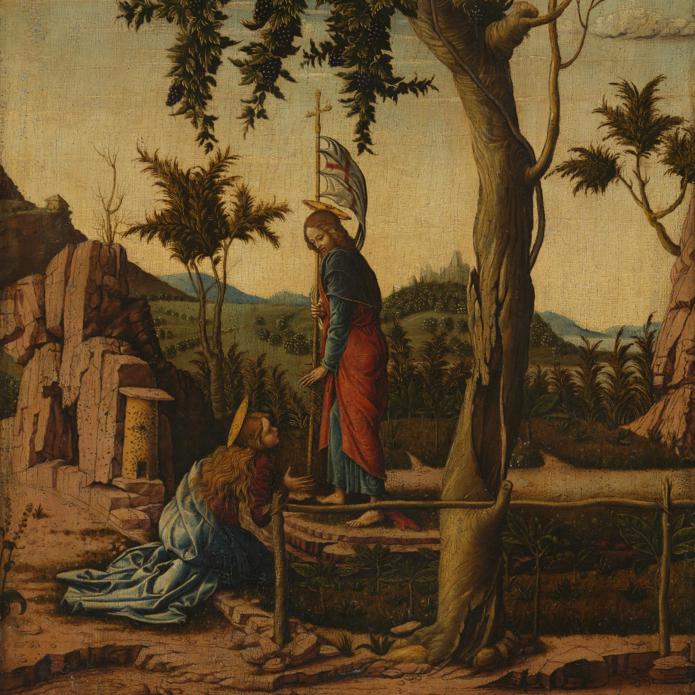Imitator of Andrea Mantegna, 'The Maries at the Sepulchre', perhaps 1460-1550
About the work
Overview
Three of Christ’s followers visited his tomb to anoint his body. When they arrived they found ‘a young man... clothed in a long white garment’ who told them that Jesus had risen from the dead (Mark 16: 1–8). In the Gospel of Matthew, the figure is described as the angel of the Lord; the painter of this panel has shown him as an angel with long blue wings. The angel reveals the empty tomb to Mary Magdalene, recognisable by her long flowing red hair, who is taken aback to see that only the burial shroud remains.
The scene is set in a rugged landscape of stony ground and craggy rocks, a characteristic feature of Mantegna’s paintings. Another natural feature often found in paintings by Mantegna is the dead tree. A symbol of death, it is contrasted with the fresh young tree that frames the figure of Mary Magdalene. The living tree symbolises the eternal life that Christ offers through his own death and resurrection.
Key facts
Details
- Full title
- The Maries at the Sepulchre
- Artist
- Imitator of Andrea Mantegna
- Artist dates
- about 1431 - 1506
- Part of the series
- Three Scenes of the Passion of Christ
- Date made
- perhaps 1460-1550
- Medium and support
- oil on wood
- Dimensions
- 42.5 × 31.1 cm
- Acquisition credit
- Bequeathed by Lady Taunton, 1892
- Inventory number
- NG1381
- Location
- Not on display
- Collection
- Main Collection
- Previous owners
Provenance
Additional information
Text extracted from the ‘Provenance’ section of the catalogue entry in Martin Davies, ‘National Gallery Catalogues: The Earlier Italian Schools’, London 1986; for further information, see the full catalogue entry.
Exhibition history
-
2008Mantegna, 1431-1506Musée du Louvre26 September 2008 - 5 January 2009
Bibliography
-
1951Davies, Martin, National Gallery Catalogues: The Earlier Italian Schools, London 1951
-
1986Davies, Martin, National Gallery Catalogues: The Earlier Italian Schools, revised edn, London 1986
-
2001
C. Baker and T. Henry, The National Gallery: Complete Illustrated Catalogue, London 2001
About this record
If you know more about this painting or have spotted an error, please contact us. Please note that exhibition histories are listed from 2009 onwards. Bibliographies may not be complete; more comprehensive information is available in the National Gallery Library.
Images
About the series: Three Scenes of the Passion of Christ

Overview
These three panels celebrate Christ’s bodily resurrection from the dead. It is likely that all three came from the same series and were painted by the same artist. The pictures reflect aspects of Mantegna’s style, particularly engravings he made at the end of the 1450s and beginning of the 1460s. The jagged rock formations, the angular folds of the draperies and the sinuous figures are particularly characteristic of Mantegna’s paintings.
The painter is unknown but technical analysis of the pigments used shows that they are unlikely to have been painted more than about 50 years after Mantegna’s death. Analysis of the underdrawing (the initial design as drawn on the panel) shows that the painter did not make any alterations to the overall design or any of the details. This suggests that they were tracing directly from a pre-existing image rather than inventing an original composition.
















